Lip & Tongue Tie in Newborns and Toddlers
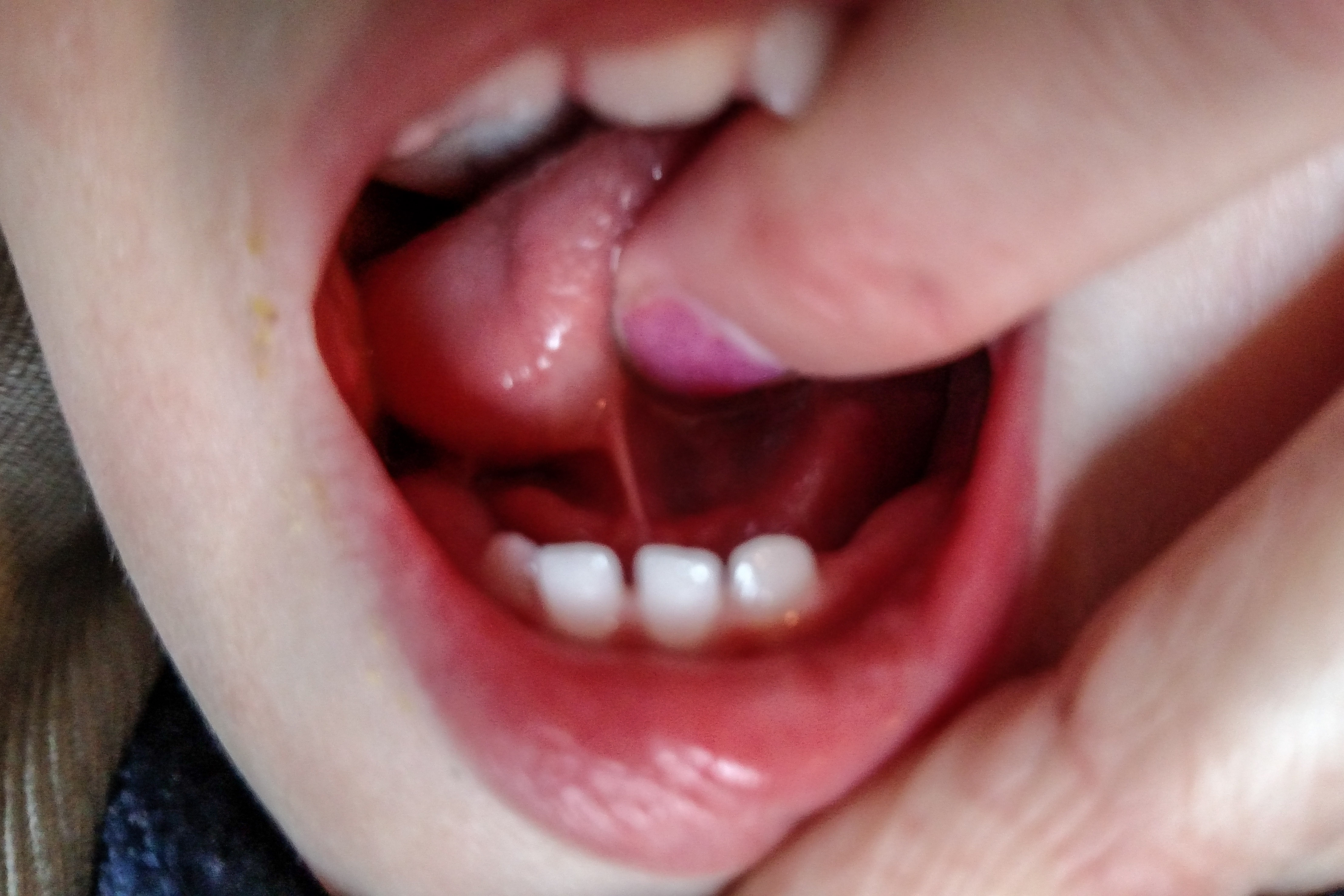
Breastfeeding your baby is wonderful except when it’s… not wonderful. If you are discouraged, in tears {because all those pregnancy hormones, you know!}, tired of trying and trying and TRYING, and about ready to give up, PLEEEEEASE just give it one more chance. Check for a tongue tie. Pictures later in this post, but just keep reading! 🙂
Check for a Lip or Tongue Tie
When Maple was born and started breastfeeding, it was not going well. It was not easy. With my first baby, latching and sucking seemed to come naturally to him and he nursed like a champ. I feel blessed that I had a really good first experience that I could compare to, so that when I was getting going with Maple, I could tell something was different. And my mommy-instinct told me something was just not right.
So in the first 48 hours of her life, I was researching like crazy. Every spare moment I was googling search words with “clicking” and “nursing” and “unable to flange lip while breastfeeding” etc. It was painful for me (well, it always is right at first, but shouldn’t be THAT painful), and she seemed to be having trouble latching and staying on. I could tell something was off with her latch because she couldn’t flange her upper lip. And she was clicking when she sucked. (Clicking is a sign of a poor latch and baby sucking air, contributing to more burps and gassiness too.)
I was trying not to worry.
I was most worried that if she couldn’t nurse properly it would affect my milk supply – which is a valid concern, I learned, with lip/tongue-tie. So I started pumping after most feedings to keep my supply up and also to prevent me from getting infections if she wasn’t drinking it all.
{BONUS TIP for new moms – I would highly recommend this anyway for your own comfort and precaution against infection while your milk comes in that first week or two. After that plan to slowly wean off the pump and let baby determine your supply. This worked so well this time around compared to last time when I tried to let baby determine supply from the get-go and guess what, newborns DO NOT DRINK MUCH and I was an uncomfortable engorged mess trying to ward off infections all the time!}
I supplemented with a bottle (of pumped breastmilk) several times a day just to give myself a break! She definitely preferred a narrow bottle nipple rather than the natural/”like mother” ones where she still had the same lip-flange, unlatching, and slow eating problems.
I went through a LOT of information, and the result was that I was quite sure this was the problem. If you stumbled upon this post because you are trying to find information about it too in hopes to help your new baby, I pray this gives you a great launch pad and equips you with confidence that your breastfeeding journey can be successful! Here is some basic general knowledge I’ll summarize for you that I’ll call the Tongue-Tie Cheat Sheet.
Tongue-Tie Cheat Sheet
- Tongue-ties are genetic. Does someone in your family remember having one as a kid? (My younger brother had a tongue-tie corrected at about age 5.)
- Lip-ties are a hint that your baby probably has a tongue-tie too. Usually there is not a lip-tie without also a tongue-tie. (Some kind of tongue-ties aren’t that obvious, as in my daughter’s case. But I could definitely see her lip-tie!)
- Clipping tongue/lip-ties almost immediately after birth used to be routine, but as breastfeeding fell out of favor and bottle feeding became the popular thing, there wasn’t a need for it as much anymore. There is a good movement helping raise awareness for it again now.
- White of Scandinavian decent is more likely to have ties, caused by the gene mutation MTHFR.
- Dr. Bobby Ghaheri and Dr. Lawrence Kotlow are experts on the topic – you will come across their names a lot.
- There are two methods for correction – laser and scissors. Choose laser, especially for a newborn!
- Join the Facebook support group, and also check for your state support group which will give a list of ‘preferred providers’ – basically doctors/dentists who are highly recommended to do the release procedure.
- Positioning tip – Often you will want to send a picture to possible providers or others for them to see if it looks like a tie to them. Lay your baby/toddler on the floor in a well-lit room and sit at their head. Position them so they are laying in between your legs with their feet pointing the same direction as your feet. This enables you to use your legs to hold their arms down, one hand to wrangle with the tongue, and one for the camera. 😛 It is much easier if you have a partner to help. This is also the correct position (the baby seems “upside-down” in your lap) for doing the stretches post-op. They don’t usually like it very much, but it’s worth it in the long run!
Symptoms
MommyPotamus has a really great post on the symptoms of you and baby and a step-by-step guide to checking for a tongue-tie.
Now for some example pictures! In all my looking on the internet I found lots of lip/tongue-tie pictures, but not so many that followed the journey and showed all the pictures before, immediately after correction, AND later on. We are now more than 6 months post-revision, so I’ll add that if I can get the kids to cooperate!
Newborn Lip-Tie
Here’s a direct before/after for the lip-tie (same as above pictures, just easier to compare.) She had a very thick tie.
Newborn Posterior Tongue-Tie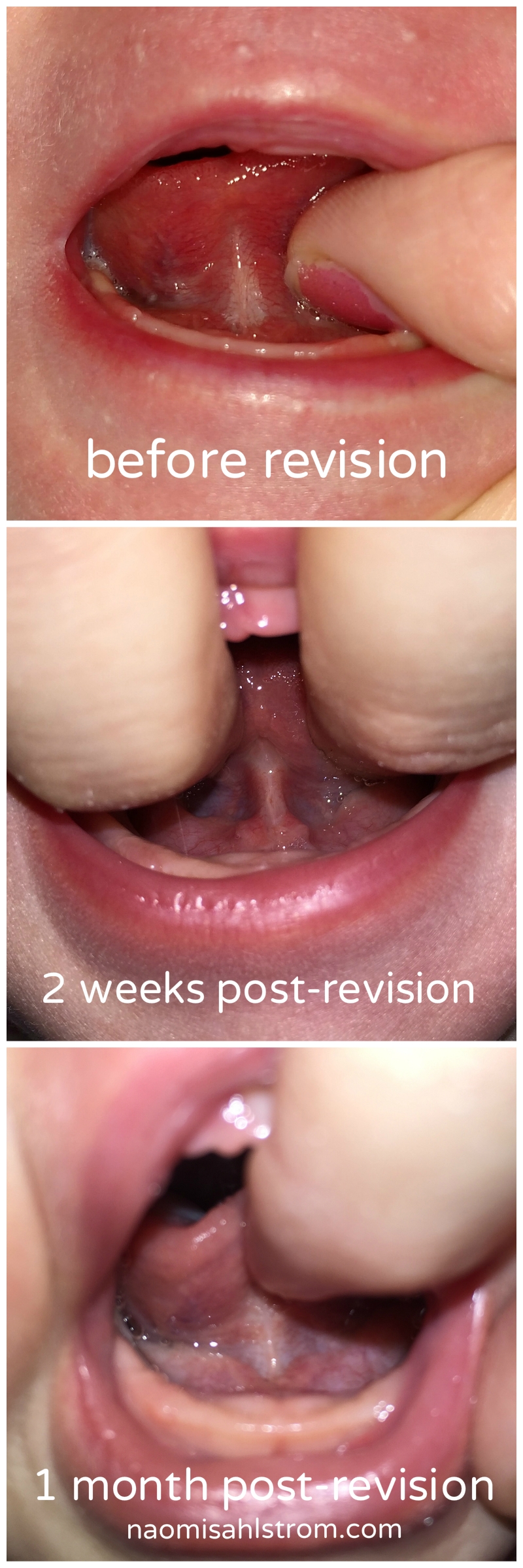
After discovering our daughter’s ties, we looked at our 18-month old son, and sure enough!
Toddler Lip-Tie
Notice how the lip-tie had caused a gap between his two front teeth. And how that gap is completely closed now! The doctor said his lip tie was more ‘thin and stretchy’.
Toddler Tongue-Tie
Check out this tongue-tie! He couldn’t even stick his tongue out past his bottom lip. It was pretty fun watching our toddler ‘discover his tongue’ like a 6-8 month old usually would.
Speech Development
At about a year he was trying to say some words, then at 18-months (the time of these pictures), he had given up trying and just babbled sounds. His friends that were his same age and even younger, were mimicking words, and saying quite a few single words with some clarity at this point. I’m a very talkative person, and he had lots of socialization, but just didn’t seem to be trying. One week after the procedure – about the time the soreness wore off – he started talking! It was like night and day difference! A lot of doctors don’t recommend doing a revision at this age (and the stretches are a challenge!), but we are really glad we did. Hopefully it will prevent speech problems in the future. Tongue and lip ties can also cause other orthodontic problems, and having had braces myself, if this is a way to possibly prevent teeth issues later on, that would be great!
6-months post-op update: His enunciation and tongue range of movement seemed to be the best at about 2 months post-op. We have noticed a slight regression from then; whether this is due to other development happening or a partial reattachment (common), we are not sure. His tongue-tie was pretty extreme, so we have a follow-up appointment next week to check it out and get a revision if needed.
UPDATE: Both kids were checked by the pediatric dentist (6 months after revision), and they said they look PERFECT! I’m relieved we don’t have to go through the revision and stretches process again! The slight bit of re-attachment is normal and they figure it in.
Choosing a Provider
We drove several hours to take our kids to one of the preferred providers with lots of experience in our state. When I was making phone calls, I called 7 – yes, SEVEN – even some out of state, places to compare prices, type (scissors or laser), and most importantly how familiar they were with doing newborns. Just for a comparison, our local health clinic had an ENT doctor who did oh… maybe 1-2 per month, but those were not necessarily infants or small children. One of the dentists in the area does the procedure, but only for adults. Compare that to the pediatric dentist we went with who does around 30 per week or so. And most of those are babies. (In the hour and a half or so that we were in the office, I saw four other babies in and out of there; with our newborn, that made 5 just in that hour!)
The Laser Procedure
I wanted the laser procedure for them, as it seems to be what is most recommended for babies, less chance of reattachment, and easier healing. No bleeding involved. 🙂 Yes, there is a little bit of pain (but older kids who have had it say it’s not bad), so they gave our 18-month old local anesthetic – numbing gel – and the baby got sugar water. At this particular office, they didn’t allow parents to be with their child, which I understand, but that is the one thing I would have liked to be different. They were gone for only about 5 minutes each; Ole wasn’t even crying when he came back.
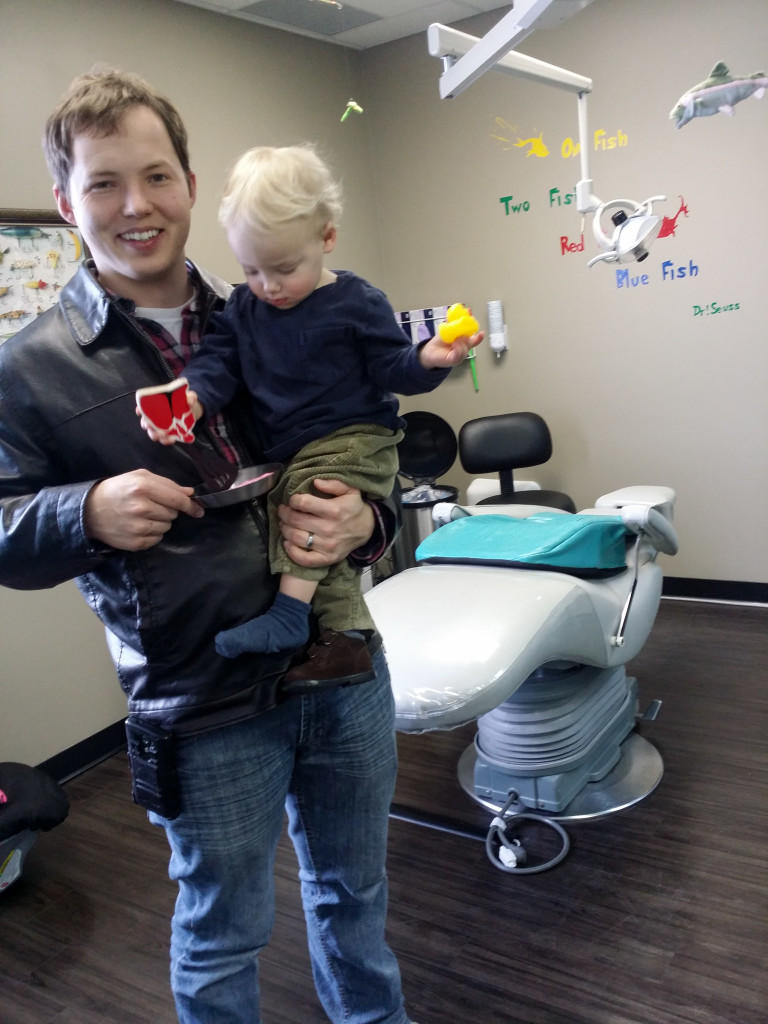
They are a bit swollen and sore for about 24 hours, but still just as cute!
Several hours after the procedure, as the numbness wore off for Olaf (above). Little chipmunk cheeks Maple (below).
The next day they bounced right back to their usual perky selves! There was only some discomfort when doing the stretches several times a day. We also did follow-up chiropractic (in place of cranial-sacral therapy) as recommended. Our son can now lick an ice-cream cone and talk up a storm!
Breastfeeding Progress
I’m sure you’re wondering, “Well, how did the breastfeeding go?” Immediately after the procedure, they have you feed your baby. Her lips flanged amazing! The first few times seemed perfect (probably it was easy to notice the stark difference because it was so recent to when it wasn’t good). The next few days and weeks there were a few times with some clicking, but overall it was 80% better. Looking back I attribute it to her learning the “new” way to breastfeed since she might have already developed habits (she was 2 weeks old at the time of the procedure). By 2 months post-op I would rate ability to breastfeed correctly at 100%! So be patient, it takes a little time for both momma and baby to get used to. At 7.5 months old, she is EBF and going strong, we are just starting to introduce her to solids, but she doesn’t have much interest yet. 🙂 She takes a bottle and two styles of pacifiers with no problem.
Tongue-ties are NOT the only cause of breastfeeding problems. Check with your midwife, doctor, and/or contact your local La Leche League to help rule out other possible culprits first. And like my midwife always tells new moms… Plan for it to take at least 6 weeks to get the hang of nursing! Don’t be discouraged!
If this helped you… Share it!
I hope this has provided you with useful information! THANK YOU to the other moms, mom bloggers and my midwives who helped me find answers in our time of need!
If your baby was tongue-tied too, or this helped you at all, please SHARE THIS POST on social media, Pin it to Pinterest, link from your blog, etc. – and don’t forget to send it to your pregnant friends too – let’s raise awareness for one of the common causes of nursing problems and help more moms have a positive breastfeeding experience!
Also, please reach out to me personally if you have more questions about our experience! Contact me via my blog or find me on Facebook. 🙂
{Links on this site may be affiliate links – I earn a small commission when you purchase, at no extra cost to you. I only share products we would use ourselves and I give my 100% honest opinion. Thank you for helping support this site so I can continue providing quality information!}

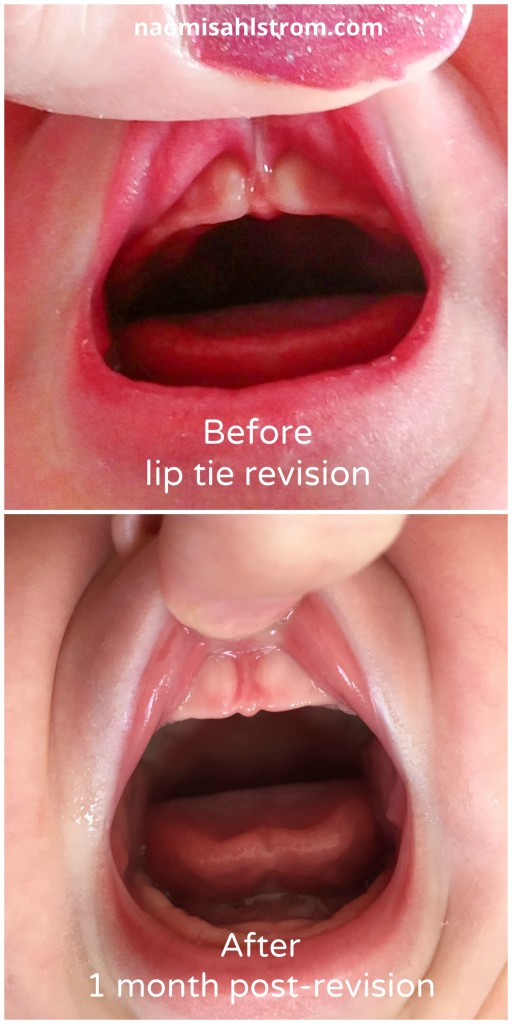

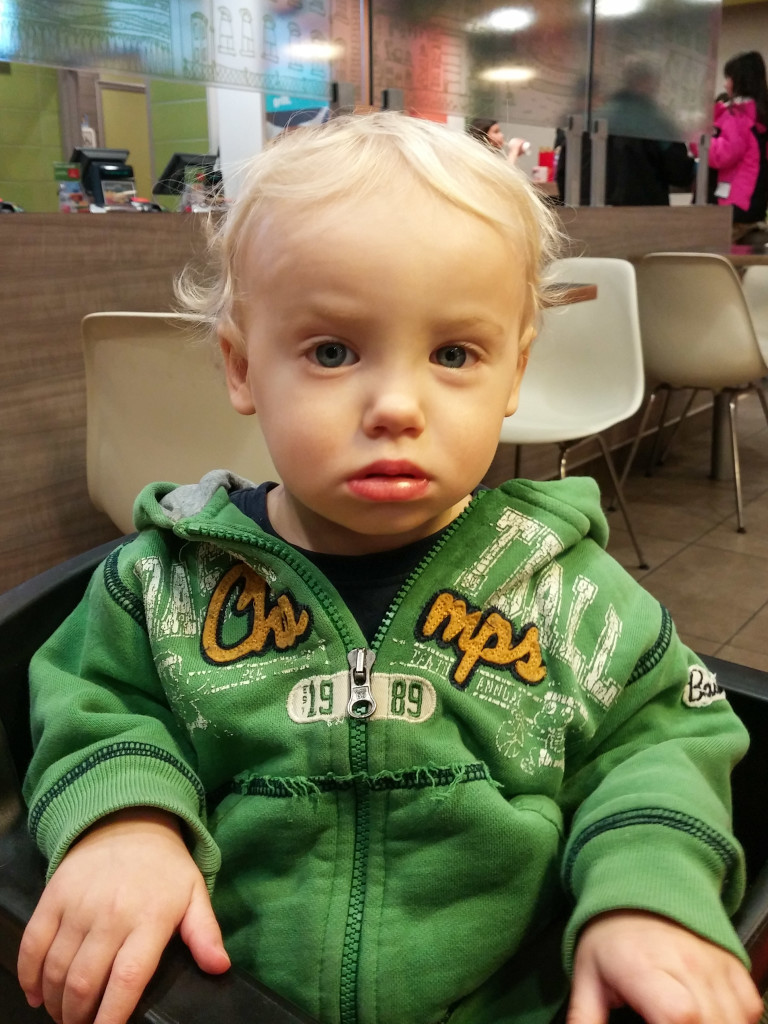



Sarah
Hi There, I was wondering what ended up happening with your 18 month old after the regression? my 16 month old has been going through the same thing and your pictures could almost be identical with my sons! he is only 2 months post op but has regressed a little bit since initial clip. ut as far as healing it is looking about the same as your sons.. im wondering if the re attachment needed to be clipped again?
naomi
Hi Sarah, we went back for the post-op checkup a full 6 months later. I was worried, like you, that they might need to be done again. 🙁 BUT Dr. Darcy said they looked GREAT – both kids! – and didn’t need to be re-released. The slight bit of re-attachment is normal and they figure it in. One year later (now), at 2.5yrs, my son is talking in full sentences and can stick his tongue waaay out! If you’re unsure about it I would call your provider. If there aren’t any symptoms though, they’ll probably think it’s fine. 😀 Hugs Momma!
sarah
Yes, there are no symptoms, except he still can’t stick his tongue out ! Did that come with time, or was it immediate?
naomi
Our son had a tie right to the end of his tongue, and he could stick it out immediately after (get them to lick something they love – ice cream, sucker, etc.). He was sensitive about it though once the local wore off… It was sore for about a week. Can you still see the white diamond (if lasered)? Keep up with the stretches for sure. Good luck!
sarah
It was cut, not lasered. And he just had a posterior tie. I’m wondering if he got used to it being restricted, and just has old habits. It pops out a bit if he coughs!
Ruth
Hi, I found your site by googling posterior ties. My 3mo old daughter just had hers laser revised and she never got the diamond wound like they told me. But when i saw your pics, her mouth looks like your posterior pics. Did your child ever get the diamond shaped wound?
naomi
Our infant did not have as clear of a “diamond” as our toddler. There was a white spot where it had been lasered, but only for a day or two (heals quick). The biggest thing in my opinion that would denote success is if the symptoms go away and breastfeeding becomes easier/possible. For us it took about a month for our daughter to relearn to nurse the correct way! It was immediately POSSIBLE for her to flange her lips, etc., but often she would fall back into the shallow latch and such. Does your doctor offer a post-op checkup? I would voice your concerns to them. My gut feeling as to why you don’t see a diamond is young bodies heal quick, and they may not have had to laser a huge area… so unless you get her mouth stretched just right (which is hard!), it may not look quite diamond-shape. So glad you got her ties corrected!
Alexandra
Hi, Did you do the stretches? My 1 month baby girl hand a lip and tongue tie revised. It was cut not laser and we made the streches almost 24 h after the procedure and she bled a little so my husband got scared and did not want to do them anymore. Now I saw the ties are reattaching and I don’t know what to do since I am worried we mighy have to cut them again. The doctor that made the frenectomy does not recommend the streches. What did you do?
naomi
Yes, we did stretches! It wasn’t very fun for the kids, but they did not have reattachment. All the preferred providers that I have heard of recommend doing stretches. You might want to get a second or third opinion from some other doctors. (I would rather be on the safe side and do the stretches so they don’t have to go through the procedure again.) A small amount of bleeding shouldn’t be a problem, especially so close to having it revised initially, however, I’m not a medical provider so I would give your doctor who did the revision a call and ask about the bleeding! You could also ask why s/he doesn’t recommend the stretches.